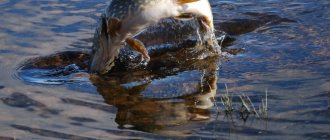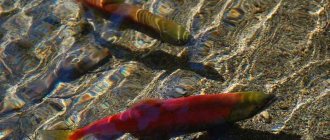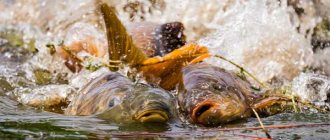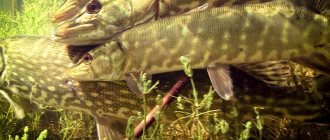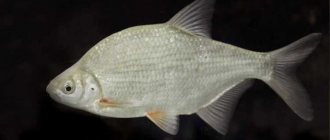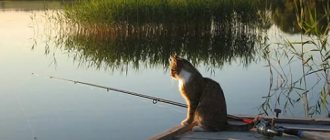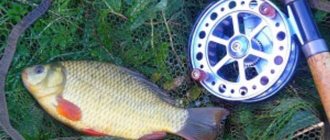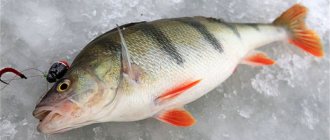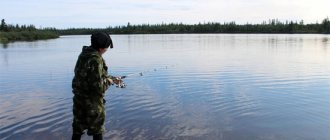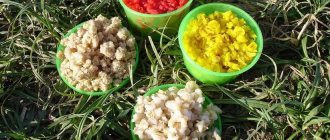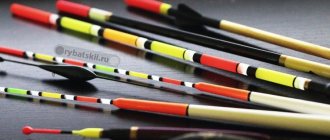Yuri 12/28/2020 472
In many Russian regions, crucian carp is considered a trash fish with mediocre taste. But it also has its fans, as it can be caught all year round. The fish is very fertile; up to 300 thousand eggs are laid during one spawning of crucian carp. The larvae develop exclusively in warm water, being glued to blades of grass and algae. Within a month, the crucian carp turns from a fry into a mature juvenile. This process is long and interesting.
When does crucian carp go to spawn?
Despite the above-described features of crucian carp spawn, whatever one may say, spawning is closely related to water temperature. Referring to various sources, we can say that the optimal temperature should be from 13 to 18 degrees. In shallow water, where the water warms up better, spawning occurs faster.
At depth, spawning of crucian carp occurs in several stages. The fish gradually moves from the shore to the heart of the reservoir. Due to the long process of spawning, the ban on catching crucian carp is being postponed. The first wave of spawning may occur at the end of May, and the second in mid-summer.
Female crucian carp have their own characteristics. For example, during spawning, she can join a school of tench, which are not able to fertilize crucian carp, but successfully help in the development of future fry.
Before going to spawn, crucian carp form in schools. If the reservoir is not large, herds may include specimens of different sizes. The spawning area is always noisy, with fish constantly jumping out of the water.
Fishing after spawning
After an illness associated with spawning, crucian carp strives to restore the energy that went into it. This time is characterized as a “post-spawning glutton” for fish, when it is even possible to change the menu and switch (together with worms and maggots) to plant bait.
A week after spawning, the crucian carp begins a period of active search for food . The success of the bite at this time is influenced by the weather and features of the reservoir. If there is a lot of vegetation in it, then the fish will have enough of it at first, which means that bait and complementary food after reproduction must be selective.
Active biting is observed on maggots and bloodworms black bread, cake and oatmeal are suitable for bait .
Warm and sunny weather significantly accelerates the activity and gluttony of fish. Cold temperatures and prolonged rains, on the contrary, slow down these processes.
Despite severe hunger, the bite of crucian carp is not predictable; it is difficult to determine how active an individual of a given size will behave. Therefore, you should be prepared for any surprise by preparing several types of equipment. Experienced fishermen advise deciding on gear right on the shore, taking into account weather conditions, wind strength and direction .
Large fish usually live in the shallows away from the shore, and the bite occurs at 7-9 a.m. or 6-8 p.m. This does not apply to days with strong winds, which cause mixing of the lake water. The choice of a mixture for spring-summer complementary feeding for crucian carp, which quickly gets used to a certain type of food, is especially important .
At the end of spawning, baiting , when complementary feeding is carried out in a limited place and at a certain time . When fishing in a permanent body of water, it is effective to accustom the fish to one type of complementary food , without changing its composition. It is advisable to include chopped maggots or bloodworms.
At the same time, there is no point in waiting for a long time for a bite. If the crucian carp does not respond to the worm, then it is replaced with maggots or bloodworms . And the tackle is raised ten centimeters when the casting distance changes.
Spawning of crucian carp in central Russia
In central Russia, crucian carp spawning begins only in late spring, usually in the second ten days of May. Spawning lasts about 30 days. In the southern regions, fish go to spawning grounds in early May, and in the north, it happens in June.
Note that in reservoirs with abundant vegetation, spawning occurs later than in reservoirs with open water. The fact is that bogs most often become completely free of ice only in June. Deep-water rivers may not warm up to the required temperature for a long time. In shallow water, crucian carp spawn much faster than in a large body of water.
Fishing during spawning
Catching crucian carp during spawning, as a rule, does not bring the expected results. The fish is so engrossed in the game that it practically does not feed. Even in the shallows, where the depth of the water allows it to move only on its side, crucian carp rarely becomes interested in the bait offered to it. But, using some tricks, ordinary float equipment, an elastic band or a feeder, you can ensure success. To do this, you need to know the peculiarities of fish behavior during spawning: You need to fish in deep water, where crucian carp spawn in several stages. If in shallow water the fish have already begun to spawn, you need to cast the tackle a little deeper, where larger individuals are just beginning to gather to play. They are not yet in the mood for fertilization, which means they may well be interested in the bait. On a familiar body of water, determine the location of the deep drop (a distance of at least 5 m from the shore). At the transitions from shallow water to pits, crucian carp waits for the spawning period. Use caddisfly larvae, bloodworms or maggots as bait, and steamed pearl barley or flavored dough for bait. Crucian carp is one of the few fish that often does not have time to restore its protein needs after winter, so bloodworms are considered the best spring bait for a float tackle or feeder.
When catching crucian carp during spawning, special attention should be paid to the time of day. The game begins when the sun is already bright enough, and the air temperature rises several degrees compared to the night. For example, in central Russia this period occurs at 8-10 o’clock in the morning, and therefore for morning fishing you need to hurry up to sunrise or transfer fishing to the daytime hours.
If underwater vegetation has not yet developed enough, try using fishing elastic for fishing. The tackle is made in the following way:
- Rubber from 5 to 15 meters long is tied to a rope with a load.
- 5-6 leashes (up to 30 cm long) are attached to a five-meter piece of fishing line.
- Using a carabiner, the equipment is secured through the winding rings to an elastic band, and then to the fishing line on the spinning rod.
For fishing to be effective, 8-10 meters of rubber and a load weighing 350-400 grams are enough. For bait, use a moving earthworm. It happens that attempts to catch crucian carp during spawning do not end in anything. There is no need to despair. You need to wait a few weeks and go fishing after spawning, when the fish begin to actively bite, restoring strength after the mating season.
Where do crucian carp spawn?
As the mating season approaches, the time comes to choose a place to raise future offspring. The choice remains with the female, who will be followed by a retinue of males.
It is not typical for crucian carp to leave their habitual place in search of spawning grounds. For such an important task, the crucian carp will choose a well-warmed place with vegetation, on which the female will attach the eggs. It is preferable if the bottom is muddy. In rivers, flow should be minimal or completely absent.
Crucian carp with mature eggs can be found in open water throughout the spring and summer.
Crucian carp is a prolific fish, ready to lay up to 300,000 eggs at a time. The higher the water temperature, the faster the eggs will develop. The larva develops within a month, being attached to algae. In 4 weeks, the formation of fins, tail and scales occurs. But, since there are enough predators in reservoirs ready to feast on fresh caviar, the survival rate of crucian carp is not too high.
Where are the fish after spawning?
After such an active period of mating games, the fish calms down for a while and gains strength. To do this, cyprinids choose quiet backwaters with an abundance of plant food, somewhere under flooded snags. The rest period for crucian carp after spawning ranges from 5 to 10 days. The duration again directly depends on the degree of warming up of the water, weather conditions and the availability of food.
The eggs attached to the algae begin to actively develop. Small embryos mature in a period of 3 to 4 days, and by autumn the fry reach a size of 5–7 cm. Not all of them manage to survive and grow into full-fledged fish.
Small crucian carp are the favorite prey of predators:
- frogs;
- newts;
- pike;
- zander;
- seagulls;
- herons;
- bedbugs;
- diving beetles.
In addition, some fry may die if the water temperature is insufficient. At first, the cubs feed on plankton, and as they grow, they switch to algae, insect larvae, leaves of aquatic plants, and bottom microorganisms.
At what age does crucian carp spawn?
Silver predators are considered early maturing. Crucian carp are ready to produce their own kind already at the age of 2-3 years. But his golden ones are lagging behind somewhat - a year or two. In fact, the rate of sexual maturity is influenced by the food supply of the reservoir and weather conditions. In ponds with poor food supply, the time for spawning occurs at a later age.
Physically, the fish is ready to throw, having reached a length of at least 10 cm and a weight of at least 100 grams. The female is usually larger than the male.
Methods of growing crucian carp
Farmers and aquaculture enthusiasts have long been experimenting with growing crucian carp using different technologies and under different conditions. The experience they have accumulated allows us to highlight several noteworthy methods of breeding it:
- In a barrel. The fish are kept mainly on mixed feed, and part of the water in the tank is regularly replaced. The volume of such a pool is limited, so breeding crucian carp in a barrel makes sense in the countryside for decorative purposes or for raising fry;
- In aquarium. The tank is equipped with filters and aerators, which, compared to a barrel, allows the fish to gain weight faster and increase the stocking density. Industrial breeding of crucian carp in an aquarium is ineffective, but it is easier to raise fry this way;
- In the ponds. It is very expensive to dig a pond, so it is easier to rent one. On the other hand, the presence of a natural food supply reduces costs, and the fish can be fed with regular grain. Each hectare of pond brings 12–15 tons of crucian carp;
- In the cages. These designs are beneficial if you have access to a natural reservoir. Thanks to feeding, the fish grows one and a half times faster than in open water, but for wintering it has to be moved to an ice-free pond;
- In the swimming pools. The method is more often used in such a business as catfish breeding at home, but crucian carp also feels good in a closed water supply installation. The downside is that it grows too slowly even under ideal conditions.
Prohibitions during spawning of crucian carp
During the spawning process, the fish are unlikely to be actively interested in food. You can catch trophies if you go fishing before or after spawning. When going for trophies to your favorite body of water in the spring, it is worth remembering that unlimited fishing can cause serious harm to the population.
Spawning restrictions are different for each region. To avoid financial penalties, it is worth studying the rules for catching crucian carp in your area every year.
During the spawning period, crucian carp can be caught exclusively with passive baits using bottom or float rods. It is forbidden to use a double or triple hook. The boat is also prohibited. Also, to avoid a fine, you should not go far into the water.
Spawning grounds are strictly prohibited, as crucian carp spawn for a long time, sometimes in tandem with valuable species of underwater inhabitants.
In general, the crucian carp population does not cause concern. Caviar develops well, both in natural and artificial conditions. However, this should not be a reason for indiscriminate fishing. After all, in addition to humans, future crucian carp have plenty of enemies in reservoirs.
Spawning process
Females spawn their eggs on aquatic plants mainly in the coastal zone. During this period, they are so careless that they can easily be caught even with a net. This, of course, is worse than any of the most sophisticated poaching methods.
Being at the reservoir at this time, you need to personally enjoy the contemplation of this true holiday of nature, rejoice at its revival.
When does crucian carp start biting after spawning?
After an important task, the crucian carp resumes its usual habits and returns to its usual habitats for food. Each region has its own peculiarities of fishing. The zhor will be affected by wind speed, precipitation, and water temperature.
In the first summer month, the reservoirs are full of vegetation, so the crucian carp has enough natural food. In subsequent months, the fish will react to earthworms, bloodworms, and maggots. Bread, flakes or cake are also suitable as bait.
During the post-spawning period, crucian carp may behave unpredictably, either abruptly grabbing the prey or slowly savoring it. The peak of the bite will be in the morning from 6 to 10 am. The exception will be windy, gloomy days.
If after spawning the fish are in no hurry to bite, you shouldn’t expect a miracle. Try to experiment with baits.
Crucian bite during the season
The entire crucian season can be divided into the following periods:
- In the spring before the spawn.
- Spawning.
- Post-spawning period.
- Summer heat.
- End of summer - beginning of autumn.
- Late fall.
- Life under the ice.
Spring
The crucian carp bite begins in the spring immediately after the water clears. First, crucian carp gather in small schools and walk along the surface of the reservoir, exposing their sides to the joyful spring sun. At this moment, they are caught with float rods at the surface of the water using light floating baits: small maggots or semolina dough.
Gradually, as the water warms up, the intensity of the crucian carp's bite increases and before spawning, in late spring in warm water, it reaches its peak. At this time, crucian carp prefers animal bait: dung or earthworm, maggots, bloodworms, bark beetle larvae, and the like.
Next comes the actual spawning of crucian carp. At this time, in large reservoirs, where, apparently, several families of crucian carp are found, the bite continues. That is, one family is already spawning, the other is just preparing for the festival of flesh. The same baits are used, animals.
Gradually, mass spawning fades away, only individual individuals reproduce, and the bite subsides to almost zero for a couple of weeks. At this time, it is almost impossible to catch crucian carp using any type of bait.
Summer
After the spawn, when the picky eaters stop getting sick, they begin to eat heavily again. The bite of crucian carp is gradually intensifying, as it seeks to recoup the energy spent on reproduction.
The post-spawning feast begins, a feature of which is a change in diet, when crucian carp, in addition to worms and maggots, begins to respond to plant baits.
Here is a small list of the crucian carp menu:
- worms;
- maggot;
- pearl barley;
- semolina in all types;
- corn;
- dough;
- bread;
- pancakes;
- peas.
With an increase in water temperature and a decrease in oxygen in it, the fish moves away from the shores into the deeper parts of the reservoir, where the bite continues, only less active. At this time, you can feel the fastidiousness of crucian carp in the broad sense of the word. It is at this time that the notorious “kerosene brick” and other fantasy baits from jokes work.
At the end of summer, the crucian carp bite resumes, with a gradual transition of the crucian carp to an animal diet.
Autumn
Early autumn, especially Indian summer, continues the period of active biting. As the water temperature drops, crucian carp feed intensively only in large flowing reservoirs. The best bait at this time is semolina with a slight garlic scent. And if until this time a variety of bait was needed throughout the season, then in late autumn this can only scare off the picky fish.
Tips from Velesovik
Many people have heard that the spawning period of crucian carp coincides with the flowering of viburnum. We hasten to inform you that the popular belief is not true, especially for the middle latitudes of our country.
Experienced fishermen know that crucian carp can be both gold and silver. The latter are more numerous. The number of silver inhabitants increases, since the females are triploid, that is, the eggs are able to be fertilized without the participation of males.
Let's tell you a few secrets about catching crucian carp.
- Fish in large bodies of water where females spawn in several stages.
- In small bodies of water, if the crucian carp has already started spawning, cast the fishing rod deeper, where large specimens “wander.”
- Live bait, worms, bloodworms, and maggots work best as bait. Bloodworms, by the way, will be a delicious source of protein, which crucian carp so lacked during spawning.
Fishing during spawning
Catching crucian carp during the natural breeding process is quite difficult. They cease to be interested in profit and do not get food. Another obstacle to fishing is the inaccessibility of these inhabitants of the aquatic fauna, because for the entire spawning period the fish swim to quiet places that are invisible to human eyes. Nature lovers can watch a fascinating spectacle - mating games.
Experienced fishermen and environmentalists do not recommend fishing at this time, not only because fishing is virtually impossible during the spawning season.
The increase in the population of crucian carp is a natural process created by nature. To compensate for the damage to the fauna caused by humans, all living things must reproduce. The various tricks that some fishermen go to in order to get a trophy even during spawning reduce the fish population. Article on the topic: Fishing for crucian carp on a feeder
Tackle for crucian carp fishing
You can catch crucian carp with bottom tackle using one of the three most common methods: donka with a feeder, donka with an elastic band and “free donka”.
Bottom tackle with a feeder is no different from the tackle used to catch other peaceful fish. The tackle consists of a rod and reel. Previously, when there was no appropriate gear, ordinary short spinning rods were used. In the modern version, a short rod, 2.1 - 2.7 m long, with a test weight of up to 30-60 g, equipped with a flexible tip, is used as a fishing rod. This rod is called a light feeder. A spinning reel with a fishing line with a diameter of 0.15-0.2 mm is attached to the feeder. Instead of a sinker, a small feeder weighing no more than 20 g is used. The feeder can either be attached to the end of the fishing line or act as a sliding sinker. In the latter case, the feeder is located above the leashes with hooks. The first option is good because the equipment almost never overlaps. The second option is good because the hooks with bait always lie exactly on the bait. This is achieved by the fact that after casting, after a minute or two, when the bait swells and falls out of the feeder, the angler pulls the line to a distance equal to the distance from the feeder to the hook.
The feeder can be easily made from thick copper wire, winding it around a mandrel with a diameter of 2-3 cm. The ends of the feeder are filled with a thin layer of lead, holes for fishing line are drilled into them and a plastic or metal tube is inserted into them. As a stopper for the feeder, it is best to use a swivel to which a leash 15-25 cm long is tied.
After casting the rig, the rod is placed on a stand so that the angle between the fishing line and the tip of the rod is 60-90 degrees. Using a reel, select the slack in the fishing line and wait for a bite. It is expressed in the twitching of the tip or its bending when pulling the fish. It should be noted that the optimal rod length is 2.1 m. On a shorter rod, bites are better visible and a short rod can be used when fishing among bushes and trees.
When fishing at night or if fishing takes place in overgrown reservoirs, it is convenient to fish using a donkey with an elastic band. An old, well-known “forbidden” tackle, which is now allowed in recreational fishing. When catching crucian carp on a donk at night, I personally used it in most cases.
The tackle consists of a very heavy sinker to which is attached aircraft model rubber, which can stretch approximately five times, or rubber for the shock absorber of the plug, which can stretch 8-10 times. At the other end of the rubber there is a fishing line attached, on which 2-3 short leashes with hooks are attached. Closer to the rod, at a distance of one and a half to three meters from the leashes, a ring of stiff wire is tied to the fishing line. The diameter of the ring is eight to ten centimeters. On the shore, at a distance of 2-3 meters from the water's edge, a peg is driven in. When the tackle is pulled out of the water to change bait or remove fish, the ring is put on the peg. Then both hands become free.
If the sinker is brought from a boat, then it makes complete sense to lower the balls of bait into the water at the place where the hooks with bait will be located.
There is one subtlety when fishing with this gear. In order not to miss a bite, you need to hold the fishing line “on your finger.” The bites, due to the fact that the rubber hides them, are very soft and unexpressed.
When fishing in very shallow and muddy bodies of water, good results are obtained by using a “free bottom”, that is, tackle without a sinker. At the end of the line there is a hook on which a bait of large size and weight is placed. It could be a bunch of worms, a piece of dough or dough with cheese. Large crucian carp take this bait in both cold and warm water. It is not possible to cast such equipment far from the shore, but if you adapt and choose the right place, then this will not be necessary, and the effect can be impressive.
In conclusion, I would like to once again note the fact that when fishing for crucian carp you need to take with you a worm, bloodworms, maggots, maggots, pearl barley, and canned corn.
You can find the original article in Russian Hunting Newspaper No. 21 - 2006.”
Gynogenesis of silver crucian carp
Crucian carp spawning has its own amazing moments. This is especially true for the easy-going silver crucian carp, which, like some other representatives of the Far Eastern fauna, has spread throughout almost all of Eurasia.
This fish is actually capable of reproduction without the participation of males of its species, whose role is performed by males of other cyprinid fish (for example, carp, lake minnows, goldfish or tench). At the same time, the milk of males of another species works as a “signaler” that only stimulates (provokes) the egg to begin development - without the exchange of chromosomes.
On the Internet (and even in some literature) you can read that the offspring of goldfish are full of hybrids. This is complete nonsense. Such statements should not be taken seriously - this is what laymen who do not have even the slightest knowledge of biology say. As mentioned above, there is no exchange of chromosomes. And it is this exchange that is the main condition for obtaining a hybrid.
Personally, I and my companions, over the course of our entire fishing practice in different reservoirs, caught a great many crucian carp, of which absolutely all were “standard” - without any unusual “hybrid” characteristics.
A clone emerges from the eggs - a complete genetic copy of the female that laid the eggs. That is why in our reservoirs virtually all silver crucian carp are female; even among a hundred or two, it is sometimes extremely difficult to find even a single male. By the way, the ability of crucian carp to rub with other fish is one of those qualities that allowed them to expand their range so significantly.
Scientists from biology call this method of reproduction gynogenesis, which is also a special case of parthenogenesis - reproduction without the participation of males at all.
Fishing for crucian carp and spawning
Most fishermen agree that catching crucian carp during spawning is a stupid activity.
You can, of course, find cases on the Internet where people managed to achieve success during this important period in the life of a crucian carp, but this is rather an exception to the rule, which proves the existence of the rule itself. However, this should not discourage you from trying on your own. In general, spawning fishing is reminiscent of a lottery, not a sport, because success depends not on preparation, selected bait and other factors, but mainly on the luck of the fisherman that day.
https://youtube.com/watch?v=8uOAAg7XoTU
The bite of crucian carp after spawning
After spawning, crucian carp's appetite rapidly increases. This is a great chance for the fisherman.
The main thing is to follow these tips:
- At first, do not experiment with bait and groundbait. If you have already fished in this body of water and everything turned out well, then be conservative.
- If within 20 minutes after the start of fishing after spawning you do not see a bite, then change the fishing depth. If this does not help, then change the bait. The last thing that can correct the situation is changing the time of day for fishing.
- Use bait a day or two before fishing.
And a little for reference. Since crucian carp lives in most cases in “stagnant” bodies of water, its eggs are very rarely washed away by the current. But this does not mean that most of the eggs become fry. Typically, most eggs are eaten by predators, insects and crayfish.
Only 30-35 percent of the eggs become fry, of which another 60 percent are killed by predators and other inhabitants of the reservoir. As a result, only 10-15 percent of caviar become full-fledged inhabitants of the reservoir.
This information is provided so that novice fishermen understand the importance of the spawning process for their hobby.
Thus, as a conclusion, we can highlight several tips for fishermen who are going to catch crucian carp:
- according to the majority of fishermen, it is not recommended to catch crucian carp during spawning, because with a high probability it could be wasted time;
- knowledge of the spawning period is necessary in order to determine the period “before” and “after” when crucian carp bites best;
- you need to take into account many seemingly minor factors: the depth and size of the reservoir, the type of crucian carp, and more;
Catching a small crucian carp is not difficult, but catching a large crucian carp is the real art of a fisherman.
How to understand that crucian carp has begun spawning
This is quite easy to do. Firstly, if you fish in the same body of water, then it’s enough to remember when spawning begins there. As a rule, from year to year it takes place at the same time with a difference of several days, which depends on the weather and the early or late arrival of spring.
A fisherman can understand that a crucian carp is spawning by seeing a fish swimming near the shore on its side
Secondly, pay attention to the water temperature. Most online resources that provide weather forecasts also contain information about the average water temperature in your region
If it fluctuates around 15-17°C, then most likely the fish has now left for spawning or is “sick” after it.
By arriving directly at the reservoir, you can also quickly understand whether the crucian carp has begun spawning. If movements are noticeable in the coastal vegetation, sounds similar to slurping are heard, then we can say with confidence that it is spawning.
When does carp bite better: before spawning or after?
The active carp fishing season begins a week or two after the end of spawning. The most successful fishing occurs in the summer, when the water temperature is 20 degrees. With the onset of cold weather or the slightest drop in water temperature, the catch drops sharply. And in mid-September - early October it stops altogether until the onset of spring.
After hibernation, carp always begin to spawn. Carp bite after spawning. actively restoring strength. Accordingly, the fish actively feed when the water warms up to 20 degrees.
In addition to the onset of the season, there are other influencing factors on fishing: weather, size and depth of the river or lake. For example, a reservoir up to 2 m deep will warm up in 4-5 days at an air temperature of 20 degrees. Therefore, you can start carp fishing under such conditions. But in deep reservoirs you should not fish at depth; it is better to stay in shallow water (1.5-2 m). In such places, the water warms up faster and absorbs more oxygen.
Using binoculars, you can observe the river or lake where carp live and feed. Especially before starting active fishing for it.
Catching carp before spawning is much more difficult, but it's worth trying
During this period, the main attention should be paid to high-protein bait. After the awakening of nature in the spring, it is useless to compete with smells
If a carp lives in a reservoir with stagnant water, after winter it will be sorely lacking in oxygen. At such a time and place, fishing will have the lowest results.
It is better to feed carp with crawlers and large worms. For carp, you should choose vegetable bait. The time for more successful carp fishing is during the day, the weather and temperature are stable. If you decide to catch carp before spawning, choose places near the mouth of the stream. There is the largest concentration of fish there.
Below is a video about catching carp on a feeder after spawning:
https://youtube.com/watch?v=56FnK911XUY
When breeding carp in your own ponds, the main focus is on preserving young fish (they rarely live to large sizes). Spawning is a very important life period for any fish.
It's spawning period for carp. end of May - mid-June. A peculiarity of carp is cases of infertility of fish. Yal fish will be tastier and fattier and more fertile. It is not too difficult to distinguish these species: barnacles have thick lips, a significantly shortened body, a small belly
Spawning is a very important life period for any fish. It's spawning period for carp. end of May - mid-June. A peculiarity of carp is cases of infertility of fish. Yal fish will be tastier and fattier and more fertile. It is not too difficult to distinguish these species: barnacles have thick lips, a significantly shortened body, and a small belly.
Prohibited bait caused a stir in Russia
About the sensational activator, which some criticize for being unsportsmanlike, others praise, but not too willingly. Apparently, so as not to be banned.
